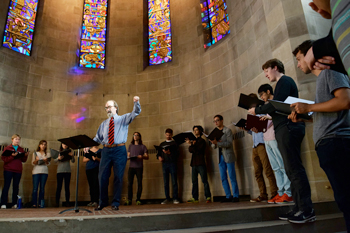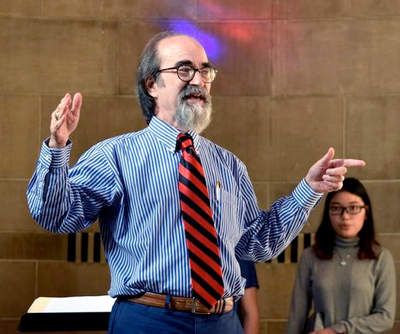by Abigail Hakel-Garcia

On Friday, November 30 and Saturday, December 1 at 8:00 pm in Fairchild Chapel, Plank will lead the ensemble in Jean Mouton’s Nesciens mater, Claudio Monteverdi’s Adoramus te, Christe a6, Felle amaro, O stellae coruscantes and Ave maris stella, Giovanni da Palestrina’s Missa Ut Re Mi Fa Sol La, Eric Whitacre’s Lux arumque, and Giovanni Gabrieli’s Cantate domino. The concerts are free and open to the public.
In his program notes, Plank suggests that while Palestrina was the musical icon of Counter-Reformation Rome, on the other hand, Claudio Monteverdi claims an equally iconic status as the master of seventeenth-century musical modernism.
In an interview Plank noted that placing the counterpoint of the two composers side-by-side makes for an interesting pairing. “You’ve got the orthodox foundational repertory, and then you’ve got that which is revolutionary pushing against that. And yet what is interesting to me is that they go together very well. They don’t feel antagonistic.”
That tug of old versus new runs throughout the entire program with its time span of hundreds of years, from Mouton in the sixteenth century to Eric Whitacre in the twenty-first. This is no random mixture of pieces — each is united by religious and/or Christmas themes.
The largest piece on the program is the Palestrina Mass which showcases the composer’s brilliant depth of style and musical ingenuity, despite being based on only six notes. The second sopranos unite the movements by singing this spare theme, but even then each repetition feels fresh with variations in textures and harmonies. While this may seem like a purely academic piece, Plank said that “the counterpoint is rich, certainly, and intellectually quite solid, but the sound that emerges from it is very gratifying.” In other words, this is a treat for the mind and the ears alike.
When asked how he chose the Whitacre, Plank said it was because of its seasonally appropriate text about golden light falling on the newborn baby Jesus. “Culturally, it has become such a hit piece that from a pedagogical standpoint people ought to have the chance to experience it.”
It also acts as a palate-cleanser after Palestrina’s subtle variations: Whitacre’s famously modern-sounding cluster chords are radically different from the work of the man who is credited with inventing the rules of counterpoint. They’re not so different as to be jarring, however — Plank said that both draw on “the cathedral ambiance.”

Plank’s goal for Collegium is to find music that allows his singers to have the experience of performing in chamber style with just a few singers on a part. “That’s a challenge, but it’s also gratifying because you can do really thickly-scored pieces like the Mouton. It requires some depths in the ranks, but we’ve got that this year.”
Another consideration is making sure the religious pieces fit as well on the concert stage as they do in their original liturgical context. This multiple framing is especially interesting in Monteverdi’s Felle Amari, which was originally conceived as the secular madrigal Crud’amarilli. “This was the piece that originally prompted the discussion of the difference between the first and second practices of Palestrina vs. Monteverdi,” Plank said. “He reframed his own piece into a sacred context by changing the text from one of unrequited love to Jesus’s lament for the unfeeling people for whom he dies. The undertones of sadness, longing, and death remain the same.”
Abigail Hakel-Garcia is a fourth-year violin major at the Oberlin Conservatory of Music who hails from Erie, Pennsylvania. She has sung in Collegium for the last seven semesters and wrote this preview for Oberlin’s Introduction to Music Journalism course.
Published on ClevelandClassical.com November 26, 2018.
Click here for a printable copy of this article



